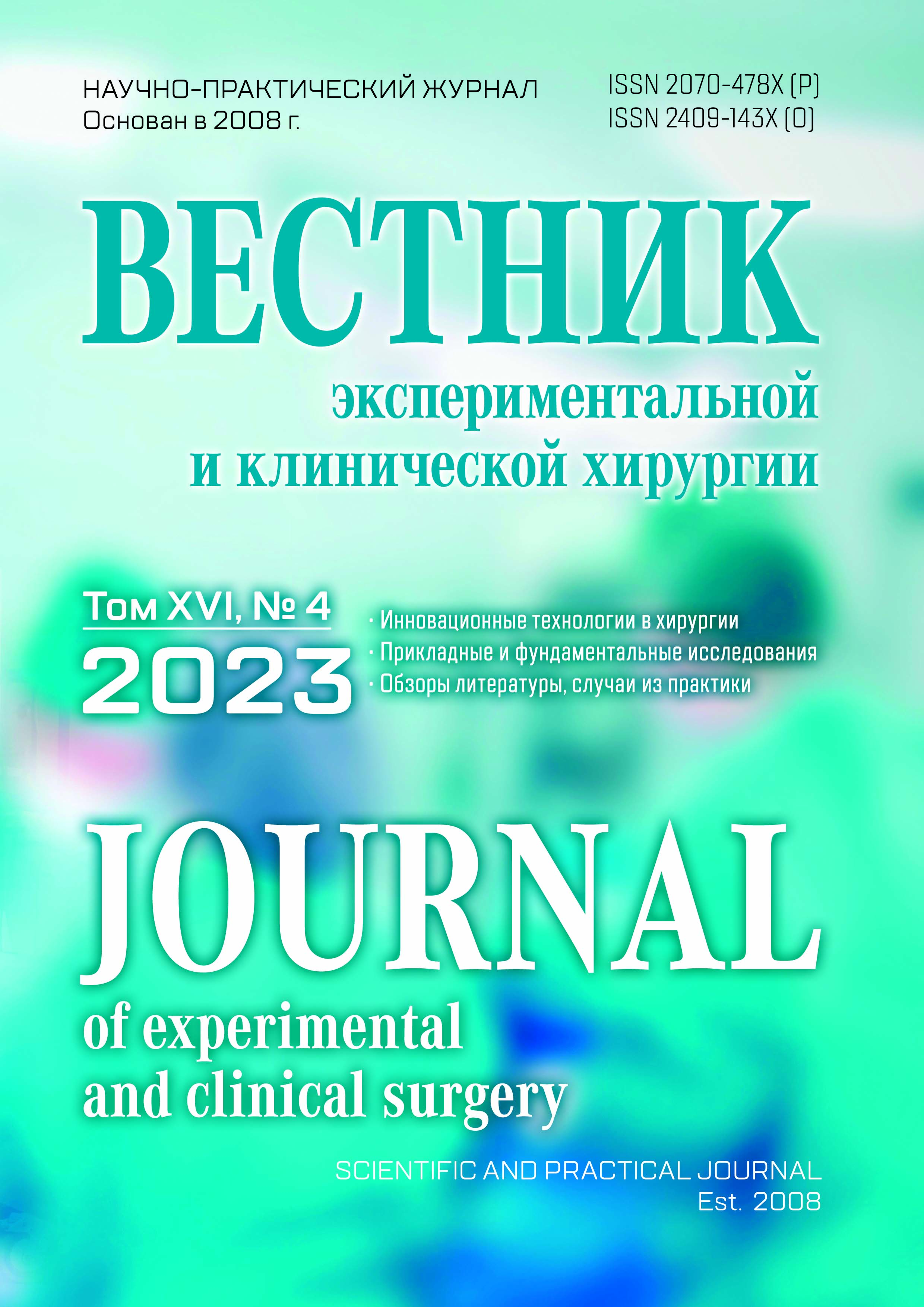Treatment of a Patient With Closed Liver Injury Using Interventional Methods: a Case Study
- Authors: Gavrishuk Y.V.1, Manukovsky V.A.2, Tulupov A.N.2, Demko A.E.2, Kolchanov E.A.2, Kiselev M.2, Pravosud M.N3
-
Affiliations:
- Saint-Рetersburg I.I. Dzhanelidze research institute of Emergency Medicine
- Saint Petersburg Research Center of Emergency Medicine named after I.I. Dzhanelidze
- Saint Petersburg Research Center of Emergency Medicine named after I. I. Dzhanelidze
- Issue: Vol 16, No 4 (2023)
- Pages: 316-320
- Section: Experience
- URL: https://vestnik-surgery.com/journal/article/view/1701
- DOI: https://doi.org/10.18499/2070-478X-2023-16-4-316-320
- ID: 1701
Cite item
Full Text
Abstract
Background. Mechanical injury occupies a leading position among the causes of mortality in the working-age population. Diagnosis and treatment of isolated and combined abdominal traumas accompanied by bleeding appear to be a specific challenge. Due to difficulties in diagnosis and treatment, they are characterized by frequent complications and an increased mortality rate.
Currently, there is no uniform tactics for diagnosing and treating patients with liver damage. In Russia and globally, new approaches are being actively introduced for the treatment of patients with closed liver traumas using minimally invasive techniques.
The aim of study was to present a clinical case of a patient with a closed liver injury treated using interventional methods, such as angiography and embolization.
Materials and methods. According to conventional techniques, the patient had to undergo laparotomy with complex manipulations to stop intra-abdominal bleeding from a ruptured liver, which would inevitably worsen her condition in the context of a presenting severe injury.
Multiple studies reported that the number of postoperative complications after laparotomy is up to 41%, and in case of combined trauma 10-35% of complications can be one of the causes of death [6, 7, 8]. In order to avoid more traumatic treatment approaches, we applied tactics using minimally invasive high-tech diagnostic and treatment options.
Results. To stop intra-abdominal bleeding from a liver rupture, which was previously diagnosed during multislice computed tomography (MSCT) with intravenous contrast, using interventional options, selective embolization of the segmental branch of the right hepatic artery was performed with an adhesive composition. The post-traumatic period proceeded without complications; in 14 days after the injury, the patient was discharged in satisfactory condition.
Conclusion. Minimally invasive and conservative treatment of patients with closed abdominal traumas using interventional radiology can be successfully applied in specialized trauma centers.
Full Text
Treatment of a liver injury with liver injury using intervational methods
Yaroslav V. Gavrishuk, Vadim A. Manukovsky, Alexander N. Tulupov, Andrei E. Demko, Evgenii A. Kolchanov, Maxim A. Kiselev, Mikhail N.Pravosud, Anastasiia E. Kamenskaya.
Saint-Рetersburg I.I. Dzhanelidze research institute of Emergency Medicine, Russia, Saint-Petersburg
The article describes the clinical experience of treatment the victim with blunt liver injury using minimally invasive methods such as angiography and embolization. The applied treatment tactics made it possible to preserve the damaged parenchymal organ of the abdominal cavity and avoid performing other more traumatic surgical interventions (laparoscopy, laparotomy).
Keywords: abdominal trauma, liver injury, angiography and selective embolization.
For citation: GavrishukYa. V., Manukovsky V.A., Tulupov A.N., Demko A. E., Kolchanov E.A., Kiselev M. A., Kazhanov I.V., Kamenskaya A.E. Treatment of a victim with a closed liver injury using interventional methods. Journal of experimental and clinical surgery.
*Corresponding author: Mikhail N. Pravosud, Saint-Рetersburg I.I. Dzhanelidzeresearch institute of Emergency Medicine, 3 Budapestkayastreet, St. Petersburg, Russia, 192242.E-mail: pravosudmikhail@yandex.ru
About the authors
Yaroslav Vasilevich Gavrishuk
Saint-Рetersburg I.I. Dzhanelidze research institute of Emergency Medicine
Email: gavyaros@mail.ru
ORCID iD: 0000-0001-7506-2992
chief of surgery unit No. 2
Russian Federation, 192242, Russian Federation, Saint-Petersburg, str. Budapeshtskaia, d. 3, liter A.Vadim Anatolievich Manukovsky
Saint Petersburg Research Center of Emergency Medicine named after I.I. Dzhanelidze
Email: manukovskiy@emergency.spb.ru
ORCID iD: 0000-0003-0319-814X
Director
192242, Russian Federation, Saint-Petersburg, str. Budapeshtskaia, d. 3, liter A.Alexandr Nicolaevich Tulupov
Saint Petersburg Research Center of Emergency Medicine named after I.I. Dzhanelidze
Email: altul@narod.ru
ORCID iD: 0000-0003-2696-4847
professor, deputy chief physician of surgery
Russian Federation, 192242, Russian Federation, Saint-Petersburg, str. Budapeshtskaia, d. 3, liter A.Andrey Evgenievich Demko
Saint Petersburg Research Center of Emergency Medicine named after I.I. Dzhanelidze
Email: demkoandrey@gmail.com
ORCID iD: 0000-0002-5606-288X
professor, deputy director for scientific work
Russian Federation, 192242, Russian Federation, Saint-Petersburg, str. Budapeshtskaia, d. 3, liter A.Evgeniy Alexandrovich Kolchanov
Saint Petersburg Research Center of Emergency Medicine named after I.I. Dzhanelidze
Email: dr_kolchanov@mail.ru
ORCID iD: 0000-0001-9716-4981
surgeon, surgery unit No. 2
Russian Federation, 192242, Russian Federation, Saint-Petersburg, str. Budapeshtskaia, d. 3, liter A.Maxim Kiselev
Saint Petersburg Research Center of Emergency Medicine named after I.I. Dzhanelidze
Email: m-kiselev-86@mail.ru
ORCID iD: 0000-0002-8412-1699
chief of endovascular surgery unit No. 2
Russian Federation, 192242, Russian Federation, Saint-Petersburg, str. Budapeshtskaia, d. 3, liter A.Mikhail N Pravosud
Saint Petersburg Research Center of Emergency Medicine named after I. I. Dzhanelidze
Author for correspondence.
Email: pravosudmikhail@yandex.ru
ORCID iD: 0000-0003-4456-6383
surgeon, surgery unit No. 2
Russian Federation, 192242, Russian Federation, Saint-Petersburg, str. Budapeshtskaia, d. 3, liter A.References
- Hinton WJ. Injuries to the abdominal viscera. Annals of Surgery. 1929; 90: 3: 351–356
- Lucas CE, Ledgerwood AM. Changing times and the treatment of liver injury. Am Surg. 2000; 66(4): 337-41. PMID: 10776869
- David Richardson J, Franklin GA, Lukan JK, Carrillo EH, Spain DA, Miller FB, Wilson MA, Polk HC Jr, Flint LM. Evolution in the management of hepatic trauma: a 25-year perspective. Ann Surg. 2000 Sep;232(3):324-30. doi: 10.1097/00000658-200009000-00004. PMID: 10973382; PMCID: PMC1421146.
- Lucas CE, Ledgerwood AM. The academic challenge of teaching psychomotor skills for hemostasis of solid organ injury. J Trauma. 2009; 66(3): 636-40. doi: 10.1097/TA.0b013e3181897ec5. PMID: 19276731
- Delgado Millan MA, Deballon PO. Computed tomography, angiography, and endoscopic retrograde cholangiopancreatography in the nonoperative management of hepatic and splenic trauma. World J. Surg. 2001; 25: 11: 1397 – 1402.
Supplementary files














